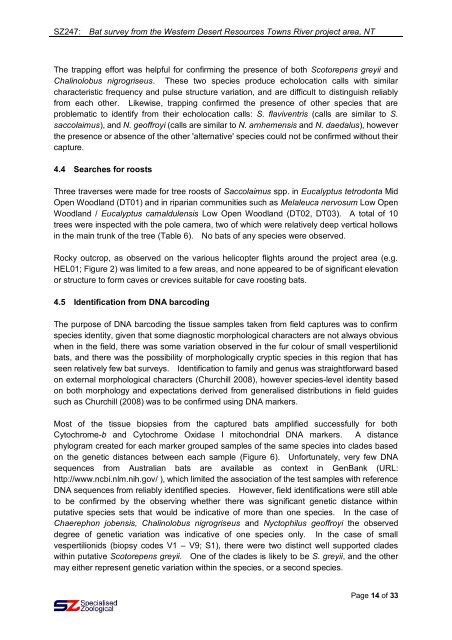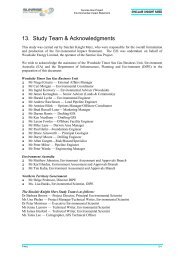Appendix D Terrestrial and Aquatic Biodiversity - Environment ...
Appendix D Terrestrial and Aquatic Biodiversity - Environment ...
Appendix D Terrestrial and Aquatic Biodiversity - Environment ...
Create successful ePaper yourself
Turn your PDF publications into a flip-book with our unique Google optimized e-Paper software.
SZ247: Bat survey from the Western Desert Resources Towns River project area, NT<br />
The trapping effort was helpful for confirming the presence of both Scotorepens greyii <strong>and</strong><br />
Chalinolobus nigrogriseus. These two species produce echolocation calls with similar<br />
characteristic frequency <strong>and</strong> pulse structure variation, <strong>and</strong> are difficult to distinguish reliably<br />
from each other. Likewise, trapping confirmed the presence of other species that are<br />
problematic to identify from their echolocation calls: S. flaviventris (calls are similar to S.<br />
saccolaimus), <strong>and</strong> N. geoffroyi (calls are similar to N. arnhemensis <strong>and</strong> N. daedalus), however<br />
the presence or absence of the other 'alternative' species could not be confirmed without their<br />
capture.<br />
4.4 Searches for roosts<br />
Three traverses were made for tree roosts of Saccolaimus spp. in Eucalyptus tetrodonta Mid<br />
Open Woodl<strong>and</strong> (DT01) <strong>and</strong> in riparian communities such as Melaleuca nervosum Low Open<br />
Woodl<strong>and</strong> / Eucalyptus camaldulensis Low Open Woodl<strong>and</strong> (DT02, DT03). A total of 10<br />
trees were inspected with the pole camera, two of which were relatively deep vertical hollows<br />
in the main trunk of the tree (Table 6). No bats of any species were observed.<br />
Rocky outcrop, as observed on the various helicopter flights around the project area (e.g.<br />
HEL01; Figure 2) was limited to a few areas, <strong>and</strong> none appeared to be of significant elevation<br />
or structure to form caves or crevices suitable for cave roosting bats.<br />
4.5 Identification from DNA barcoding<br />
The purpose of DNA barcoding the tissue samples taken from field captures was to confirm<br />
species identity, given that some diagnostic morphological characters are not always obvious<br />
when in the field, there was some variation observed in the fur colour of small vespertilionid<br />
bats, <strong>and</strong> there was the possibility of morphologically cryptic species in this region that has<br />
seen relatively few bat surveys. Identification to family <strong>and</strong> genus was straightforward based<br />
on external morphological characters (Churchill 2008), however species-level identity based<br />
on both morphology <strong>and</strong> expectations derived from generalised distributions in field guides<br />
such as Churchill (2008) was to be confirmed using DNA markers.<br />
Most of the tissue biopsies from the captured bats amplified successfully for both<br />
Cytochrome-b <strong>and</strong> Cytochrome Oxidase I mitochondrial DNA markers. A distance<br />
phylogram created for each marker grouped samples of the same species into clades based<br />
on the genetic distances between each sample (Figure 6). Unfortunately, very few DNA<br />
sequences from Australian bats are available as context in GenBank (URL:<br />
http://www.ncbi.nlm.nih.gov/ ), which limited the association of the test samples with reference<br />
DNA sequences from reliably identified species. However, field identifications were still able<br />
to be confirmed by the observing whether there was significant genetic distance within<br />
putative species sets that would be indicative of more than one species. In the case of<br />
Chaerephon jobensis, Chalinolobus nigrogriseus <strong>and</strong> Nyctophilus geoffroyi the observed<br />
degree of genetic variation was indicative of one species only. In the case of small<br />
vespertilionids (biopsy codes V1 – V9; S1), there were two distinct well supported clades<br />
within putative Scotorepens greyii. One of the clades is likely to be S. greyii, <strong>and</strong> the other<br />
may either represent genetic variation within the species, or a second species.<br />
Page 14 of 33



